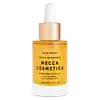What's inside
What's inside
 Benefits
Benefits

 Ingredients Side-by-side
Ingredients Side-by-side

Opuntia Ficus-Indica Seed Oil
EmollientVitis Vinifera Seed Oil
EmollientSimmondsia Chinensis Seed Oil
EmollientArgania Spinosa Kernel Oil
EmollientCalendula Officinalis Extract
Skin ConditioningOpuntia Ficus-Indica Seed Oil, Vitis Vinifera Seed Oil, Simmondsia Chinensis Seed Oil, Argania Spinosa Kernel Oil, Calendula Officinalis Extract, Curcuma Longa Root Oil, Boswellia Serrata Oil, Viola Odorata Extract, Hippophae Rhamnoides Oil, Rosa Damascena Extract, Vanilla Planifolia Fruit Extract, Viola Odorata Oil, Zingiber Officinale Root
 Reviews
Reviews

Ingredients Explained
These ingredients are found in both products.
Ingredients higher up in an ingredient list are typically present in a larger amount.
Hippophae Rhamnoides Oil also known as seabuckthorn oil. This oil is usually extracted from the fruit pulp or seeds.
Seabuckthorn is rich in phytosterols, carotenoids, Vitamins A, C, and E. This gives it strong antioxidant properties that can help soothe and protect your skin from oxidative damage.
This oil is rich in fatty acids, including: two types of linoleic acid (~30-34%), oleic acid (17%), and palmiteic acid (35%). Note these numbers are averages, and different parts of the plant will vary.
Palmitoleic acid has been shown to help soothe inflammation and promote wound healing. It is also naturally found in the fat of our skin.
Overall, seabuckthorn oil is great for nourishing, hydrating, and soothing skin. While it shows UV protecting properties, it should not replace sunscreen.
Due to the rich fatty acid content, this ingredient may not be Malassezia folliculitis, or fungal acne, safe.
Seabuckthorn berries are little orange fruits. This plant is native to Asia.
Learn more about Hippophae Rhamnoides Oil